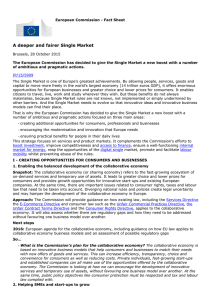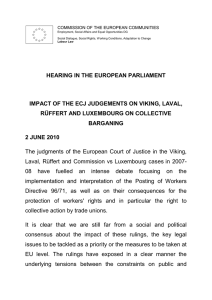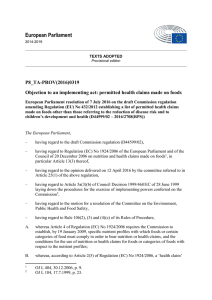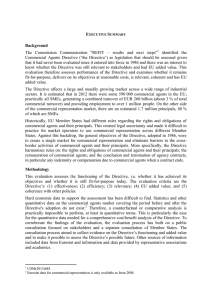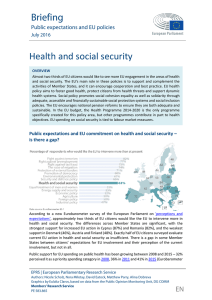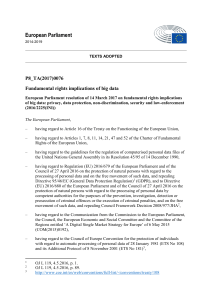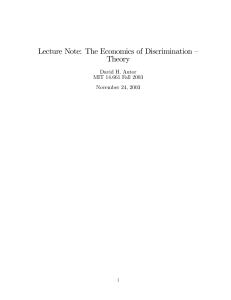en en draft report - European Parliament
Anuncio
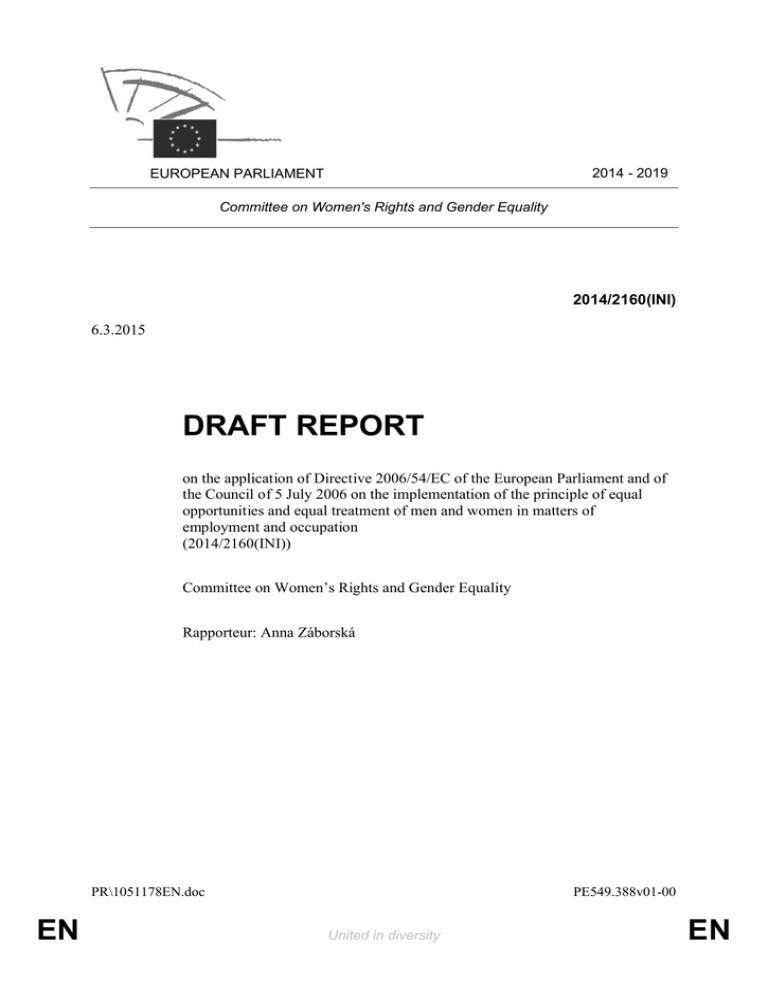
2014 - 2019 EUROPEAN PARLIAMENT Committee on Women's Rights and Gender Equality 2014/2160(INI) 6.3.2015 DRAFT REPORT on the application of Directive 2006/54/EC of the European Parliament and of the Council of 5 July 2006 on the implementation of the principle of equal opportunities and equal treatment of men and women in matters of employment and occupation (2014/2160(INI)) Committee on Women’s Rights and Gender Equality Rapporteur: Anna Záborská PR\1051178EN.doc EN PE549.388v01-00 United in diversity EN PR_INI CONTENTS Page MOTION FOR A EUROPEAN PARLIAMENT RESOLUTION ...........................................3 EXPLANATORY STATEMENT...........................................................................................9 PE549.388v01-00 EN 2/12 PR\1051178EN.doc MOTION FOR A EUROPEAN PARLIAMENT RESOLUTION on the application of Directive 2006/54/EC of the European Parliament and of the Council of 5 July 2006 on the implementation of the principle of equal opportunities and equal treatment of men and women in matters of employment and occupation (2014/2160(INI)) The European Parliament, – having regard to Articles 2 and 3 of the Treaty on European Union (TEU) and Articles 8, 10, 19 and 157 of the Treaty on the Functioning of the European Union (TFEU), – having regard to Directive 2006/54/EC of the European Parliament and the Council of 5 July 2006 on the implementation of the principle of equal opportunities and equal treatment of men and women in matters of employment and occupation (recast)1, – having regard to the Commission recommendation of 7 March 2014 on strengthening the principle of equal pay between women and men through transparency (C(2014)1405), – having regard to the Commission communication of 6 December 2013 entitled ‘Report on the application of Directive 2006/54/EC of the European Parliament and the Council of 5 July 2006 on the implementation of the principle of equal opportunities and equal treatment of men and women in matters of employment and occupation (recast)’ (COM(2013)0861), – having regard to the Commission communication of 21 September 2010 entitled ‘Strategy for equality between women and men 2010-2015’ (COM(2010)0491), – having regard to the Commission communication of 5 March 2010 entitled ‘A Strengthened Commitment to Equality between Women and Men, A Women’s Charter’ (COM(2010)0078), – having regard to the European Pact for Gender Equality (2011-2020) adopted by the Council on 7 March 2011, – having regard to the case law of the Court of Justice of the European Union (CJEU), based on Article 157 TFEU, – having regard to the provisions of the International Labour Organisation’s (ILO) 1994 Part-Time Work Convention, which requires countries to incorporate into their public procurement contracts a labour clause including the issue of equal pay, – having regard to ILO Convention 100: ‘Equal Remuneration’, – having regard to Article 11(1)(d) of the Convention on the Elimination of All Forms of Discrimination against Women, adopted in UN General Assembly Resolution 34/180 of 1 OJ L 204, 26.7.2006, p. 23. PR\1051178EN.doc 3/12 PE549.388v01-00 EN 18 December 1979, – having regard to its resolution of 12 September 2013 on the application of the principle of equal pay for male and female workers for equal work or work of equal value1, – having regard to its resolution of 24 May 2012 with recommendations to the Commission on application of the principle of equal pay for male and female workers for equal work or work of equal value2, – having regard to the European Implementation Assessment of Directive 2006/54/EC produced by the Directorate-General for Parliamentary Research Services, – having regard to Rule 52 of its Rules of Procedure, – having regard to the report of the Committee on Women’s Rights and Gender Equality and the opinion of the Committee on Employment and Social Affairs (A8-0000/2015), A. whereas the equal treatment of men and women is one of the fundamental principles of EU law; B. whereas discrimination based on sex, racial or ethnic origin, religion or belief, disability, age or sexual orientation is prohibited by EU law; C. whereas the principle of equal pay was enshrined in the Treaties since the very beginning in 1957; whereas the principle of equal pay for work of equal value is now recognised under Article 157 TFEU and incorporated in the recast Directive 2006/54/EC (the ‘recast Directive’); D. whereas the ‘recast Directive’ was meant to make EU legislation in this area more coherent and bring it into line with CJEU case law and to bring about the simplification and modernisation of the relevant equality laws at national level, thus contributing to the improvement of the situation of women in the labour market; E. whereas the ‘recast Directive’ introduced some novelties, such as the implementation of the equal opportunities principle and the definition of the concept of indirect discrimination, and made explicit reference to the reconciliation of work, private and family life; whereas the impact of these novelties in Member States remains limited; F. whereas the practical application of provisions on equal pay in the Member States was acknowledged as one of the most problematic areas; whereas, according to the latest figures, the gender pay gap still exists, standing at 16.4 %, and despite existing EU legislation and soft-law recommendations, progress in this area is extremely low; G. whereas relative progress has been made as regards women’s employment rates, but despite the existing framework at EU and national level, the level of occupational and sectoral segregation of women and men into different types of jobs remains relatively high, a situation which also has an impact on the gender pay gap over the course of a lifetime; whereas vertical segregation, whereby women feature predominantly in lower- 1 2 Texts adopted, P7_TA(2013)0375. OJ C 264 E, 13.9.2013, p. 75. PE549.388v01-00 EN 4/12 PR\1051178EN.doc paid occupations or are in lower-level positions in the hierarchy, also contributes to the pay gap; H. whereas motherhood and care for the elderly represent additional work that is for the most part carried out by women; whereas this work is neither paid nor valued by society, even though it contributes to social welfare and can be measured by economic indicators such as GDP; whereas this results in the widening of the income gaps that exist between women and men through the ‘costs’ of the years spent out of the labour market or of reduced hours due to part-time arrangements; whereas the impact of these elements on lifetime earnings varies across the Member States depending on the level of support given to parents, by either legislative measures or collective agreements; I. whereas women receive on average 39 % less than men in pensions; whereas this situation could be the result different factors, such as the level of participation of women in paid labour, the employment structure of various sectors, the time spent in work, and the gender pay gap; whereas this increases the risk of poverty for women in retirement; J. whereas the ‘recast Directive’ clearly indicates that any forms of less favourable treatment in relation to pregnancy or maternity leave constitutes discrimination; whereas the ‘recast Directive’ clearly provides for a guarantee of return to work after maternity leave to the same job or equivalent post and a protection from dismissal for men and women when they exercise the right to parental and/or adoption leave; K. whereas social partners and civil society organisations play a very important role in fostering equal treatment and promoting the concept of work based on equal pay; L. whereas equality bodies should be adequately supported in the performance of their tasks as regards the promotion, monitoring and support of equal treatment in an independent and effective manner; M. whereas Parliament has repeatedly called on the Commission to review existing legislation in order to tackle the gender pay gap; whereas closing the gender pay gap would represent a means of increasing employment rates among women and decreasing the risk of poverty for women at pension age; Overall assessment 1. Takes note that, in general, Members States have brought their national laws into line with EU law1; points out that simply transposing correctly the provisions of the ‘recast Directive’ into national law has proved insufficient in order to achieve the full application and effective enforcement thereof; 2. Underlines the fact that the Member States were obliged to transpose only those ‘substantive changes’ brought about by the ‘recast Directive’ which had not been clearly identified; underlines the fact that the Commission’s efforts to monitor implementation were limited in their impact as regards ensuring a coherent approach and securing the necessary guidance in order to allow for effective implementation at national level; 1 According to Commission report on the application of the recast Directive (COM(2013)0861), PR\1051178EN.doc 5/12 PE549.388v01-00 EN 3. Calls, therefore, on the Commission to identify the weak points of the ‘recast Directive’ and prepare the legislative proposal that would replace it; Application of the equal pay provisions 4. Takes note that direct discrimination as regards pay appears to have lowered in Member States and that the evaluation of work, in particular that which is done through collective agreements, continues to be the main problem; 5. Underlines the fact that in accordance with CJEU case law, the principle of equal pay must be observed in respect of each of the elements of remuneration granted to men and women; 6. Reiterates the need for clear definitions of different concepts at EU level, such as gender pay gap, remuneration, direct and indirect pay discrimination, work treated as ‘equal’ and work of the same value; points out that due to the various types of work contracts that exist, the current calculation of the gender pay gap can lead to a distorted understanding of the problem of equal pay; calls on the Commission to analyse possible distortions and propose a solution; 7. Calls on the Commission and the Member States to map the application of the existing job evaluation and classification systems which vary considerably; calls on the Commission to introduce guidelines for neutral job evaluation and classification systems, including specific measures, such as the proportional representation of women and men on evaluation committees, the development of neutral job descriptions and of weighting grids, and the definition of clear criteria for assessing the value of work; 8. Points out that a clear and harmonised job classification system and wage transparency will improve access to justice; notes that several Member States have already taken specific wage transparency measures; underlines the disparity that exists between these measures and takes note of the 2014 Commission recommendations on wage transparency; calls on the Commission to evaluate the real impact of these recommendations; Application of the equal treatment provisions 9. Underlines the fact that occupational pensions schemes are to be considered as pay and that the principle of equal treatment applies to these schemes; calls on the Commission to monitor closely and report on the implementation of this principle as the transposition has proved to be unclear in some Member States and the distinction between statutory and occupational schemes still poses problems in certain cases; 10. Takes note that in the implementation of the provisions on the protection against discrimination in relation to maternity leave and paternity and/or adoption leave, there are significant differences between Member States; underlines the need to address in a coherent way at national level the specific challenges that exist, including the sectoral (public-private) and organisational (between companies) differences, the situation as regards atypical and part-time contracts, and the practices of terminating fixed-term contracts in the protection period and inducing voluntary job resignations; PE549.388v01-00 EN 6/12 PR\1051178EN.doc 11. Calls on the Commission and the Member States, by creating effective monitoring systems, to take actions to improve the collection of data on harassment and discrimination cases on the grounds of sex, including as regards discrimination related to pregnancy and maternity and other forms of leave; 12. Points out that access to justice in this field is limited due to several causes, such as the length or costs of the procedures, the absence of free legal aid or the fear of victim stigmatisation in the workplace; underlines the fact that the application of the burden of proof rule also poses problems in several Member States; calls on the Member States to support equality bodies, trade unions and NGOs in taking an active role in providing assistance to victims of discrimination; 13. Calls on the Commission to assess the existing best practices and to disseminate the results of this assessment as regards the effective measures that Member States could take to encourage employers and organisations involved in vocational training to prevent all forms of discrimination on the grounds of sex, in particular as regards harassment and sexual harassment in the workplace, through enhancing access to employment, offering further vocational training and promoting best practices; Promotion of equal treatment and dialogue 14. Reiterates that equality bodies should have the power to monitor and report effectively and independently on the legislation which promotes equality between women and men; 15. Calls on the Commission and the Member States to encourage social partners to promote the monitoring of equality practices in the workplace, the further scrutiny of collective agreements, applicable pay scales and job classification schemes in order to avoid any direct or indirect discrimination of women; calls on the Member States to strengthen the obligations for large and medium-sized enterprises to ensure the systematic promotion of equal treatment and to provide the appropriate information on a regular basis to their employees, including on issues of equal pay; 16. Calls on the Commission and the Member States to strengthen the institutional mechanisms to implement equality between women and men, and to encourage the social partners to measure the equality dimension of collective agreements; 17. Calls on the Commission and Member States to step up significantly awareness raising measures as regards the rights of the victims of discrimination on the grounds of sex; underlines the need for cooperation by all stakeholders, including social partners and NGOs, to address stereotypes about the work of women and men and how they impact on the value of work and low pay; 18. Points out that one of the novelties introduced by the ‘recast Directive’ is the reference to the reconciliation of work, private and family life; calls on the Commission, after consultation with Member States and social partners, to develop specific measures to secure stronger rights in this field; Recommendations 19. Reiterates its call on the Member States to implement and enforce recast Directive PR\1051178EN.doc 7/12 PE549.388v01-00 EN 2006/54/EC consistently, to encourage the social partners to play a more active role in fostering equal treatment, including by means of action plans to address any unjustified gender pay inequalities, with concrete actions and outcome monitoring, at company, sectoral, national and EU level; 20. Calls on the Commission, following its report on the application of the ‘recast Directive’ and this resolution, to review the former, as has already been called for by Parliament, in particular in its resolution of 24 May 2012, which contains specific and clear recommendations; 21. Underlines the fact that neutral job classification and evaluation, as well as wage transparency, are indispensable measures in order to foster equal treatment; calls on the Commission, in this connection, to include these measures in its proposal for a new directive replacing the ‘recast Directive’; points out that only a harmonised approach is compatible with the free movement of workers as a basic European freedom; 22. Calls on the Commission to introduce in the new directive sanctions at EU level that would exclude companies found guilty of infringing the equality principle from the public procurement of goods and services financed from the EU budget; 23. Calls on the Member States to take the necessary measures to ensure that victims of unequal treatment and discrimination are entitled to proportionate compensation in accordance with the legal provisions in force; 24. Underlines the fact that only the effective implementation of the equality treatment principle would lead to a real improvement of the situation of women in the labour market and that this requires strategic cooperation between different actors at European, national, sectoral and organisational level; 25. Calls on the Commission to look into the factors leading to pension gaps and to assess the need for specific measures to reduce this gap at EU and national level, including by means of legislative and/or non-legislative measures; 26. Calls on the Commission to conduct a study that would compare the situation of mothers and women without children; points out that the aim of such a study should be to shed more light on the position of these women on the labour market, specifically targeting levels of employment and pay gaps, career development and pensions; 27. Points out that the country-specific recommendations, which come under the framework of the European Semester, should include targets to reduce the gender pay gap; 28. Instructs its President to forward this resolution to the Council and the Commission. PE549.388v01-00 EN 8/12 PR\1051178EN.doc EXPLANATORY STATEMENT General remarks Equal treatment of men and women in employment and occupation is a matter of freedom and justice. It is a non-negotiable part of the social contract. All women regardless of their age, education or social status are the potential victims of discrimination on the workplace, directly or indirectly. Sometimes, the discrimination is so subtle that it can be revealed only by thorough analysis of relevant statistical data. The impact of the inequality in the field of employment cannot be underestimated. It hampers the potential of women, thus not allowing the society to fully use their talents, skills, and abilities. Thus, the equal pay for women and men is a matter of fairness and motivation. At the same time, it can also be understood as a family issue. The well-being of many families in Europe relies on women’s wages. A large majority of mothers participate on the labour market, and many of them bear the main responsibility for supporting their families as sole or primary breadwinners. Thus, the gender pay gap has a serious impact on living conditions, nutrition, and life opportunities of their children. Delivering efficient policies aimed at closing the gender pay gap can improve situation of many families, especially those with single parent, and with parents working in low-paid jobs. Equal treatment and the principle of non-discrimination is an important part of both EU primary legislation since the adoption of the Treaty of Rome in 1957 (most recently incorporated in Article 157 TFEU), and in the case law of the CJEU. However, during the last decade the gender pay gap as an important indicator of inequality between men and women on the labour market remained almost stagnant, from 17.5 % in 2008 to 16.4% in 2012. In the light of this stagnation the rapporteur is inclined to conclude that the current Directive 2006/54/EC (recast) has reached its limits, and needs to be updated. This conclusion is further supported by the previous positions of the European Parliament, most notably the initiative resolution 2011/2285(INI) Equal pay for male and female workers for equal work or work of equal value with recommendations to the Commission (Bauer report). Gender Pay gap The gender pay gap (GPG) is calculated as the difference between the average gross hourly earnings of male and female employees as a percentage of average gross hourly earnings of male paid employees. The resulting percentage is an important indicator of the inequality between women and men on the labour market as the calculation takes in account both fulltime and part-time jobs (the later have in general lower hourly wages, while being dominated by women). The definition of GPG makes it sensitive to three types of disturbances that set limitations to its interpretation: individual characteristics (e.g. education – if women with low education stay out of the labour market then GPG falls, whereas if they need the income and go to work the GPG widens as employees with higher education earn more), industry characteristics (e.g. firm size – workers in large firms tend to have higher earnings then those working for smaller companies), and institutional characteristics (minimum wage – higher minimum wage PR\1051178EN.doc 9/12 PE549.388v01-00 EN decreases GPG, as many women work in low-paid jobs). This is why it is important to compare the overall GPG with a gap recorded in specific sectors. While a considerable pay gap can be observed between part-time and full-time employees, this gap is not necessarily the result of direct discrimination. Rather, it is a consequence of the fact that part-time jobs are more frequent in low-paid sectors, such as healthcare or cleaning services. The internal comparison of hourly wages among part-time workers shows that the gender pay gap is smaller than when compared to full-timers. In order to tackle the inequality between women and men as manifested by the GPG, it is necessary to identify the underlying motivation of many women regardless their education and talents to choose jobs of lower market value. Imbalance between work and family Women are the main carers, spending disproportional amount of time doing unpaid work and providing care for their children and other family members. In order to do this, they often choose working part-time. They also dominate positions in sectors and occupations that allow for better balance between work and family life. This results in women being often employed in low-paid jobs and not to take on management positions. But while men work longer hours than women in the workplace, if women’s paid and unpaid working hours are combined they are significantly longer than men’s. At the same time, the tension between family and professional life contributes to the postponement of having the first child and to low fertility rates in most Member States. Employment rates of women with small children are constantly lower than women without children. Moreover, according to expert analysis, the gender pay gap starts to be visible after a woman’s return to the labour market from her first maternity leave, gets higher with repeated career interruptions because of external factors, such as child-related employment breaks and caring for dependent family members and tends to grow with age. 1 Due to periods of maternity- and family-related leave women experience significant interruptions of professional experience that also contribute to the GPG. The direct impact of such periods include loss of wage and its replacement by maternity allowance, in many Member States also accompanied by a lower social security benefit during this period. This is also why the gender pay gap is lowest for young employees and increases with age as a result of the career interruptions described above. The inability to offer women practical solutions that would help them better reconcile work and family responsibilities is the main factor contributing to horizontal/sectorial and vertical/occupational segregation of the labour market. As a result, women often work in sectors offering lower hourly wages than the sectors dominated by men, such as healthcare, education or public administration. At the same time, women are facing vertical or occupational segregation that is a result of prejudiced roleassigning in the male-dominated society: they are too often found employed as administrative 1 European Parliament resolution of 24 May 2012 with recommendations to the Commission on application of the principle of equal pay for male and female workers for equal work or work of equal value (2011/2285(INI) PE549.388v01-00 EN 10/12 PR\1051178EN.doc assistants, shop assistants or low-skilled or unskilled workers. The rapporteur stresses the need to take in account the nexus between specific role of women as childrearer, and their willingness to accept unfair treatment on the labour market. This is why she strongly suggests that the provisions aimed at creation of optimal conditions for work-family balance take in account the importance of unpaid work of women as carers and adequately recognize the value of this unpaid work. To this respect, it may be necessary to change the calculation of GPG so that it excludes women with one or more children. That way, the GPG would only reflect the real pay gap resulting from discrimination. At the same time, a comparison between the pay gap as calculated now, and the “bare” GPG based on the new calculation could be used as a basis to estimate the debt owed by society to women for their unpaid work as caretakers. Discrimination in pension schemes The pay gap between women and men widens after retirement. According to available statistics, women in the EU receive on average 39% less in pensions than men. This development reflects disadvantages in career which becomes evident when occupational pensions are compared. On average, pension gaps are considerably higher than pay gaps. That is caused by the higher proportion of women working part-time, by lower hourly wages, and less years in employment. In some member states, the pension gap reached levels that are almost double compared to the pay gap. Resulting inequality may further grow as the demographic situation in the Member States deteriorates. That will put pay-as-you-go pension systems under increasing pressure and private pension funds managing savings calculated as percentage of earned wage become the main source of income for retired citizens. The rapporteur understands the pension gap as extension of the pay gap: as such, it is discriminatory and must be eliminated. Equal work concept Whereas there is a clear link between persisting indirect discrimination of women on the labour market, and the special status of a woman as potential or actual mother/child-bearer, the missing definition of work of equal value or any clear assessment criteria for comparing different jobs constitutes another major obstacle in delivering fair labour market based on equal treatment of women and men. The Recast directive in Recital 9 states that “in order to assess whether workers are performing the same work or work of equal value, it should be determined whether, having regard to a range of factors including the nature of the work and training and working conditions, those workers may be considered to be in a comparable situation.” So far, twelve Member States have introduced a definition of this concept in their legislation. In most of these cases, it is based on the four main components of evaluation of work introduced in the Annex 1 of the Commission Staff Working Document accompanying the Report on the application of Directive 2006/54/EC: skills, effort, responsibility and working conditions. The rapporteur proposes that the concept of equal work or work of equal value should be introduced in all Member States as a mandatory requirement as a contribution to basic European freedom of movement of workers. PR\1051178EN.doc 11/12 PE549.388v01-00 EN Wage transparency Introduction of wage transparency measures is another important step towards building a labour market based on equality between women and men. The rapporteur is convinced that mandatory inclusion of this tool based on common European definition would make a positive impact as it would on one hand raise the awareness of employees of existing remuneration and benefit disparities while at the same time provide an instrument for victims to initiate court proceedings in discrimination cases. Access to justice The monitoring of the implementation of the Recast directive reveals that the access to justice for the victims of discrimination varies substantively across the Member States. In order to overcome the main obstacle the victims face in most of the Member States, the rapporteur underlines the need of free legal aid. This could be offered by equality bodies, trade unions or NGOs. Improvement in the access to justice is also a precondition for application of compensation and penalties clauses under the Recast directive. While compensations enable the courts to grant victims appropriate remedies, sanctions and penalties have detrimental effect on employers and provide motivation to avoid any form of behaviour that could be interpreted as discriminatory. Following the principle of subsidiarity, sanctions suggested by rapporteur should be specifically imposed on the EU level and affect the admissibility of companies in public procurements of goods and services paid from EU budget. PE549.388v01-00 EN 12/12 PR\1051178EN.doc


